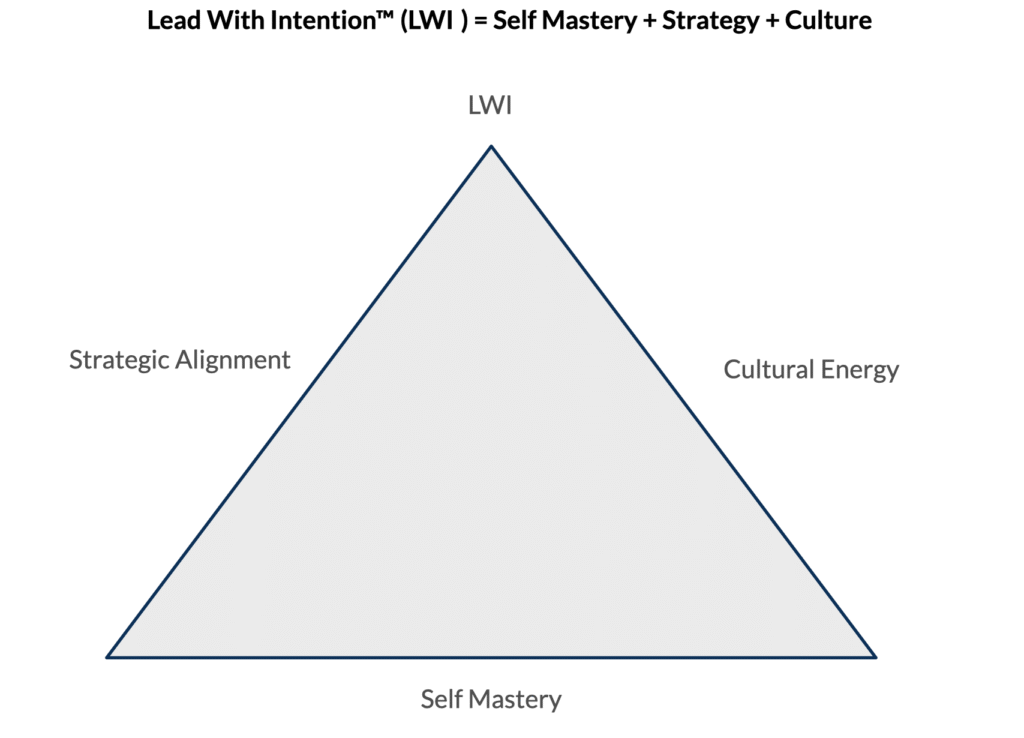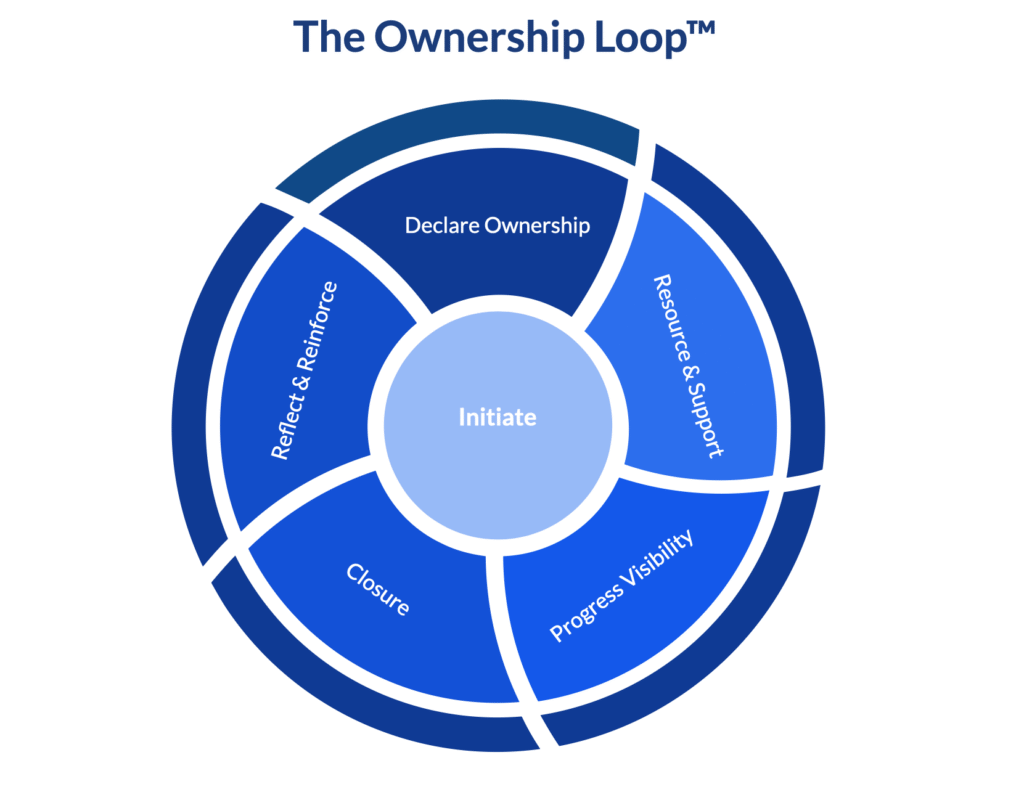
Lead With Intention™: The Leadership Practice That Drives Scalable Growth
Business growth is rarely linear. Even as markets expand, products evolve, and capital flows, mid-sized companies often hit unexpected walls—projects stall, teams misalign, execution falters. More often than not, the underlying challenge isn’t external—it’s internal. Specifically, whether leadership capacity can scale in step with complexity.
Lead With Intention™ (LWI) is a strategic leadership practice grounded in neuroscience, developmental psychology, and practical experience. It enables executives to expand their capacity to guide organizations through complexity by integrating:
- Self-Mastery: Maintaining composure, focus, and cognitive clarity under pressure, improving decision speed and reducing errors.
- Strategic Focus: Aligning decisions, teams, and resources around what matters most, increasing execution reliability and organizational alignment.
- Cultural Energy: Shaping and sustaining a high-performance culture informed by behavioral science and developmental principles, boosting engagement, retention, and accountability.
In short, Lead With Intention™ equips leaders to navigate complexity with clarity and impact—ensuring strategy and culture rise together to drive meaningful business impact.
The Walls
Mid-sized companies typically encounter two walls:
- Growth accelerates, complexity spikes, and what once worked starts breaking down.
- Early momentum fades, progress stalls, and the cause isn’t immediately clear.
The signals differ, but the underlying problem is usually the same: leadership capacity hasn’t kept pace with complexity.
At this point, more capital, headcount, or strategy tweaks won’t solve the issue. What’s needed is a leadership system built to scale—not just more leaders, but more scalable leadership. That starts with Lead With Intention™.
Lead With Intention™ (LWI) In Action
Visualize this as a triangle, where each element plays a distinct, scientifically grounded role: The base/ foundation is Self Mastery, Side 1 is Strategic Alignment and Side 2 is Cultural Energy.
LWI can be expressed formally as a formula: LWI = Self Mastery + Strategic Alignment + Cultural Energy

The Base (Foundation) – Self-Mastery: The foundation. Neuroscience shows that stress narrows cognitive bandwidth, limiting the ability to process complexity and make high-quality decisions. Developmental psychology demonstrates that leadership capacity is not fixed; executives can expand executive function, emotional regulation, and decision-making under pressure. Leaders with self-mastery recognize patterns, manage impulses, and anchor their teams in clarity, resulting in faster, higher-quality decisions and reduced operational errors.
The Sides – Strategic Alignment & Cultural Energy: These rising sides of the triangle must develop together:
- Strategic Alignment: Neuroscience-informed approaches help leaders prioritize effectively under stress, ensuring faster decision-making, better cross-functional alignment, and more predictable execution.
- Cultural Energy: Drawing on developmental psychology and behavioral science, leaders shape accountability, engagement, and motivation to sustain a high-performance culture, reducing turnover, increasing ownership, and strengthening team resilience.
The Apex – Intentional Leadership: At the apex of the triangle (the top point, not a strict geometric term), intentional leadership unites strategic clarity, execution, and culture into a single force.
Leaders at the apex channel complexity into clarity and momentum.
They focus on what matters most, guiding people, decisions, and culture with purpose. Stress is not eliminated—it is transformed into a force that drives alignment, engagement, and measurable performance gains, including faster time-to-decision, consistent execution, and improved retention.
The Triangle Metaphor
The triangle metaphor illustrates stability: a wide, solid base (self-mastery) supports balanced sides (strategy + culture), culminating in intentional leadership at the apex. If any element falters—misaligned strategy, weak culture, or limited self-mastery—the structure destabilizes and performance suffers.
Why This Matters for Mid-Sized Companies
For executives leading mid-sized businesses, speed is both an advantage and a vulnerability.
The faster growth accelerates, the more pressure is placed on the leadership system.
Under strain, even seasoned leaders may default to:
- Over-functioning or micromanagement
- Reactive, short-term decision-making
- Cultural drift and inconsistent execution
Lead With Intention™, grounded in neuroscience and developmental psychology, provides a structured way to expand leadership capacity, allowing executives to navigate complexity with clarity, intentionality, and measurable results.
The SCALE Edge™ Framework
The SCALE Edge™ is the broader framework in which Lead With Intention™ resides. It’s designed for mid-sized, growth-stage companies and integrates decades of leadership experience with science-based principles.
It focuses on five essential dimensions:
S – Structure with Flexibility: Build systems that bring clarity without limiting adaptability.
C – Clarify Purpose and Priorities: Align on what truly matters—especially when everything feels urgent.
A – Activate Accountability: Drive execution through ownership and trust, not micromanagement.
L – Lead With Intention™: Scale leadership capacity alongside organizational complexity using scientifically informed methods.
E – Energize Culture: Reinforce values and behaviors that accelerate performance and trust.
All five dimensions are essential, but Lead With Intention™ is the pivot point, where they converge into a leadership system that delivers sustained, strategic performance.
What LWI Enables
Leaders who apply this system can:
- Stay grounded, resilient, and strategic under pressure, making faster and higher-quality decisions
- Align teams and resources around clear priorities, increasing execution reliability and cross-functional effectiveness
- Build accountability structures that don’t rely on micromanagement, improving ownership and engagement
- Sustain a culture that accelerates results without exhausting people, reducing turnover and increasing retention
- Expand their own leadership capacity while empowering others to lead, multiplying organizational capability
This approach has been applied in high-growth software firms, healthcare organizations, and regional service businesses, uncovering hidden leadership constraints and enabling executives to scale alongside their organizations.
Closing the Leadership Gap
Growth rarely falters due to a lack of opportunity.
It stalls when leadership capacity doesn’t keep pace with complexity.
Without a structured system, leadership bottlenecks emerge, execution falters, and culture erodes. This structured approach, grounded in neuroscience and developmental psychology, closes this gap enabling leaders to adapt, scale, and deliver measurable outcomes.
By aligning leadership capacity with organizational growth, companies maintain clarity, coherence, and momentum. Leadership becomes a force multiplier, not a constraint.
“I stopped trying to hold everything together through sheer effort. The system showed me what to strengthen—and what to let go. That’s when momentum truly returned.” — CEO, Mid-Market SaaS Company
Where to Start
To get started on the path to scaling leadership, reflect on these critical questions:
Under pressure, do we lead from intention—or reaction?
- Are we making decisions based on thoughtful strategy, or simply reacting to immediate challenges and stressors as they arise?
Where is complexity starting to outpace our leadership system as we scale?
- As our organization grows, where are gaps appearing between our current leadership system and the rising demands of the business?
- Are our leadership practices evolving alongside the increasing complexity of operations, teams, and markets?
Are we acting as stabilizers—or becoming the constraint to growth?
- In the face of accelerated growth or stalled momentum, is our leadership empowering others to lead and driving the organization forward?
- Or are we unintentionally creating bottlenecks through over-functioning, micromanaging, or failing to delegate effectively?
Reflecting on these questions is not philosophical—it’s structural. The answers reveal whether your leadership system can scale alongside your organization—or whether it may become the limiting factor to growth.
Leadership: Limiter or Multiplier
Your business will never scale beyond the capacity of its leadership.
That’s not judgment—it’s design.
When leaders operate with clarity, alignment, and intention, the organization moves with speed, coherence, and visible traction.
When they don’t, the company either burns out—or slows down.
Whether accelerating or restarting stalled momentum, Lead With Intention™ is the internal lever that drives external scale. Strategy, product, and market matter—but in a growing company, nothing matters more than how leadership shows up.
Because at scale, leadership is no longer about holding everything— it’s about knowing what to hold, and what to let go.
Next in the SCALE Edge™ Series: Energize Culture
The next article in the series explores how leaders intentionally shape culture to scale trust, resilience, and performance—without losing clarity or identity.






